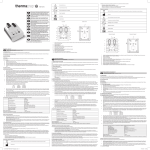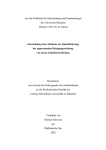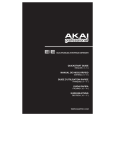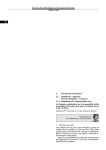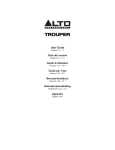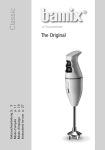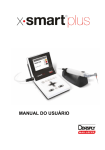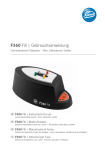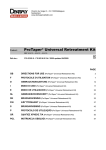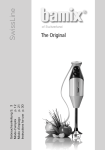Download DIrEcTIoNS For uSE WAVEoNE® GoLD INSTrumENTS moDE D
Transcript
• Remove a WAVEONE® GOLD file when it does not easily progress. Clean and inspect the cutting flutes, then irrigate, recapitulate with a size 010 file and re-irrigate. • These files are driven in precise forward/reverse reciprocating angles and must be used in reciprocating motion with dedicated Dentsply Maillefer motors. • WAVEONE® GOLD files are sold sterile and are non-autoclavable. • WAVEONE® GOLD uses a unique approach in wire processing that increases the resistance to cyclic fatigue compared to standard NiTi. Due to this processing, WAVEONE® GOLD files may appear slightly curved. This is not a manufacturing defect. It is not necessary to straighten the file prior to use. Once inside the canal, the WAVEONE® GOLD file will follow the glide path, conforming to natural curvatures. Directions for use Sterile Reciprocating Files Ref. A0750 5. ADVERSE REACTIONS In common with all mechanically-driven root canal instruments, WAVEONE® GOLD files should not be used in cases of severe and sudden apical curvature due to high risk of breakage. 6. STEP-BY-STEP INSTRUCTIONS FOR WAVEONE® GOLD FILES PT Português NL Nederlands FI SV Denna bruksanvisning finns även att tillgå på följande språk: Portugisiska (PT), Holländska (NL), Finska (FI), Svenska (SV), Danska (DA), Grekiska (EL), Polska (PL), Litauiska (LT), Lettiska (LV) och Estniska (ET). Svenska DA Denne brugsanvisning kan også rekvireres på følgende sprog: Portugisisk (PT), Hollandsk (NL), Finsk (FI), Svensk (SV), Dansk (DA), Græsk (EL), Polsk (PL), Litauiske (LT), Lettiske (LV) og Estiske (ET). Dansk Αυτή η οδηγία είναι επίσης διαθέσιμη, κατόπιν ζήτησης, στις ακόλουθες γλώσσες: Πορτογαλέζικη (PT), Oλλaνδική (NL), Φιλανδέζικη (FI), Σουηδική (SV), Δανέζικη ( DA), Ελληνική (EL) Πολωνική (PL), Λιθουανίας (LT), Λετονίας (LV) και Εσθονίας (ET). EL Ελληνική Ta instrukcja obsługi jest równieżdostępna, na zamówienie, w następujących wersjach językowych: Portugalski (PT), Holenderski (NL), Fiński (FI), Szwedzki (SV), Duński (DA), Grecki (EL), Polski (PL), Litewski (LT), Łotewski (LV) i Estoński (ET). PL Polski LT Lietuvių k. LV ET Eesti Deze gebruiksaanwijzing is, op aanvraag, eveneens verkrijgbaar in de volgende talen: Portugees (PT), Nederlands (NL), Fins (FI), Zweeds (SV), Deens (DA), Grieks (EL), Pools (PL), Litouws (LT), Lets (LV) en Ests (ET). Käyttöohje on saatavana myös seuraavilla kielillä: Portugali (PT), Hollanti (NL), Suomi (FI), Ruotsi (SV), Tanska (DA), Kreikka (EL), Puola (PL), Liettuan (LT), Latvian (LV) ja Viron (ET). Suomi Latviešu Este manual de utilização está também disponível, quando requisitado, nas seguintes línguas: Português (PT), Holandês (NL), Finlandês (FI), Sueco (SV), Dinamarquês (DA), Grego (EL), Polacos (PL), Lituânia (LT), Letónia (LV) e Estónia (ET). Šį instrukcijų vadovą pagal užklaus ą galima gauti ir šiomis kalbomis: Portugalų (PT), Olandų (NL), Suomių (FI), Švedų (SV), Danų (DA), Graikų (EL), Lenkijos (PL), Lietuviųk (LT), Latviųk (LV) ir Estųk (ET). Šī rokasgrāmata pēc pieprasījuma ir pieejama arī šādās valodās: Portugāļu (PT), Holandiešu (NL), Somu (FI), Zviedru (SV), Dāņu (DA), Grieķu (EL), Poļu (PL), Lietuviešu valodās (LT), Latviešu (LV) un Igauņu (ET). See juhend juhend on saadaval ka taotluse korral järgmistes keeltes: Portugali (PT), Hollandi (NL), Soome (FI), Rootsi (SV), Taani (DA), Kreeka (EL), Poola (PL), Leedu (LT), Läti (LV) ja Eesti (ET). Visit our website: www.dentsplymaillefer.com FOR DENTAL USE ONLY EN Directions for use WAVEONE® GOLD instruments Sterile Reciprocating Files - Ref. A0750 WAVEONE® GOLD instruments for endodontic treatment: • • • • SMALL WAVEONE® GOLD file No 020 .07 PRIMARY WAVEONE® GOLD file No 025 .07 MEDIUM WAVEONE® GOLD file No 035 .06 LARGE WAVEONE® GOLD file No 045 .05 6.1Radiographic Evaluation Review different horizontally angulated radiographs to diagnostically determine the width, length, and curvature of any given root and canal. 6.2Access Preparation Create straight-line access to the canal orifice(s) with emphasis on flaring, flattening, and finishing the internal axial walls. 6.3Precautions • Irrigate abundantly and frequently after removing any given WAVEONE® GOLD file from a canal. • Use a gentle inward pecking motion, with short 2–3 mm amplitude strokes, to passively advance the WAVEONE® GOLD file along a smooth, reproducible glide path. • Remove a WAVEONE® GOLD file when it does not easily progress. Clean and inspect the cutting flutes, then irrigate, recapitulate with a size 010 file and re-irrigate. 6.4 WAVEONE® GOLD SHAPING TECHNIQUE 1) Establish straight-line coronal and radicular access. 2) In the presence of a viscous chelator, use a size 010 hand file to verify a glide path to length. In more restrictive canals, use a size 010 hand file in any region of a canal to create a glide path. 3) Expand this glide path to at least 0.15 mm using either a manual or dedicated mechanical file, such as PATHFILE or PROGLIDER. 4) ALWAYS initiate the shaping procedure with the PRIMARY file (025/07 red) in the presence of sodium hypochlorite. 5) Use gentle inward pressure and let the PRIMARY file passively progress through any region of the canal that has a confirmed glide path. After shaping 2-3 mm of any given canal, remove and clean the PRIMARY file, then irrigate, recapitulate with a size 010 hand file and re-irrigate. 6) Continue with the PRIMARY file, in 2-3 passes, to pre-enlarge the coronal two thirds of the canal. 7) Utilize a brushing motion on the outstroke to eliminate coronal interferences or to enhance shaping results in canals that exhibit irregular cross-sections. 8) In more restrictive canals, use a size 010 hand file, in the presence of viscous chelator, negotiate to the terminus of the canal. Gently work this file until it is completely loose at length. 9) Establish working length, confirm patency and verify the glide path. 10)Expand this glide path to at least 0.15 mm using a manual or mechanical glide path file. 11) Carry the PRIMARY file to the full working length in one or more passes. Upon reaching length, remove the file to avoid over-enlarging the foramen. Inspect the apical flutes; if they are loaded with dentinal debris, then the shape is finished *. 12)If the PRIMARY doesn’t progress then use the SMALL file (020/07 yellow) in one or more passes to working length and then use the PRIMARY file to working length to optimize the shape 13)When the shape is confirmed, proceed with 3-D disinfection protocols. * If the PRIMARY file is loose at length with no dentinal debris in the apical flutes, continue shaping with MEDIUM file (035/06 green) and/or LARGE file (045/05 white) until the apical flutes are loaded. 7. DISINFECTION, CLEANING AND STERILIZATION WAVEONE® GOLD is intended for single-use only. Disinfection, cleaning and sterilization procedures are not recommended. Re-use of WAVEONE® GOLD can increase the risk of cross contamination and breakage. COMPOSITION The cutting part of these instruments is made of nickel-titanium alloy. 1. INDICATIONS FOR USE These instruments are to be used only in a clinical or hospital environment, by qualified users, following good dental practices (using gloves, glasses, rubber dam …). WAVEONE® GOLD instruments are for use in endodontic treatment, by shaping & cleaning the root canal system. RÉSERVÉ À L’USAGE DENTAIRE FR Mode d’emploi instruments WAVEONE® GOLD 2.CONTRAINDICATIONS 3.WARNINGS Instruments WAVEONE® GOLD pour traitement endodontique: In common with all mechanically driven root canal instruments, WAVEONE® GOLD instruments should not be used in cases of severe and sudden apical curvatures. This product contains nickel and should not be used for individuals with known allergic sensitivity to this metal. 4.PRECAUTIONS • The WAVEONE® GOLD files are single-use instruments. • Clean flutes frequently and check for signs of distortion or wear. • Irrigate abundantly and frequently after removing any given WAVEONE® GOLD file from a canal. • Always initiate the shaping procedure with the PRIMARY WAVEONE® GOLD file in the presence of sodium hypochlorite. • Use a gentle inward pecking motion, with short 2–3 mm amplitude strokes, to passively advance the WAVEONE® GOLD file along a smooth, reproducible glide path. WAVEONE GOLD_0115_DFU_EN-FR-DE-ES-IT.indd 1 • • • • Limes à rotation alternée stériles – Ref. A0750 Lime SMALL WAVEONE® GOLD No 020 .07 Lime PRIMARY WAVEONE® GOLD No 025 .07 Lime MEDIUM WAVEONE® GOLD No 035 .06 Lime LARGE WAVEONE® GOLD No 045 .05 COMPOSITION La partie tranchante de ces instruments est en alliage nickel-titane. 1. INDICATIONS D’UTILISATION Ces instruments sont destinés à une utilisation en milieu médical ou hospitalier uniquement, par des utilisateurs qualifiés, respectant les bonnes pratiques de dentisterie (port de gants, lunettes, digue…). Les instruments WAVEONE® GOLD sont utilisés en traitement endodontique pour la mise en forme et le nettoyage du système canalaire. 2.CONTRE-INDICATIONS Comme tous les instruments de traitement canalaire mécanisés, les instruments WAVEONE® GOLD ne doivent pas être utilisés en cas de courbure apicale brusque et sévère. * Si la lime PRIMARY est dégagée sur toute la longueur, sans débris dentinaires dans les spires apicales, continuer la mise en forme avec la lime MEDIUM (035/06 verte) et/ou la lime LARGE (045/05 blanche) jusqu’à ce que les spires apicales soient chargées. 7. DÉSINFECTION, NETTOYAGE ET STÉRILISATION WAVEONE® GOLD est prévue pour un usage unique. Les procédures de désinfection, nettoyage et stérilisation ne sont pas recommandées. Réutiliser une lime WAVEONE® GOLD peut accroître le risque de contamination croisée et de rupture. 3. MISES EN GARDE Ce produit contient du nickel et ne doit pas être utilisé pour les individus présentant une sensibilité allergique connue à ce métal. 4.PRÉCAUTIONS • Les limes WAVEONE® GOLD sont des instruments à usage unique. • Nettoyer souvent les spires et vérifier tout signe de déformation ou d’usure. • Irriguer abondamment et fréquemment après le retrait de toute lime WAVEONE® GOLD d’un canal. • Toujours commencer la procédure de mise en forme avec la lime PRIMARY WAVEONE® GOLD en présence d’hypochlorite de sodium. • Effectuer un léger mouvement de va-et-vient de faible amplitude (2 à 3 mm) afin de permettre une pénétration passive de la lime WAVEONE® GOLD le long d’un couloir d’irrigation régulier et reproductible. • Lorsqu’une lime WAVEONE® GOLD ne progresse plus facilement, l’enlever. Nettoyer et vérifier les arêtes de coupe, puis irriguer, répéter avec une lime de taille 010 et irriguer à nouveau. • Ces limes sont entraînées selon des angles de va-et-vient alternés précis et sont réservées à une utilisation en mouvement alterné avec des moteurs spéciaux Dentsply Maillefer. • Les limes WAVEONE® GOLD sont vendues stériles et ne sont pas autoclavables. • WAVEONE® GOLD utilise une approche unique du traitement des fils qui offre une meilleure résistance à la fatigue cyclique que le NiTi standard. Grâce à ce traitement, les limes WAVEONE® GOLD peuvent présenter une légère courbure. Cela n’est pas un défaut de fabrication. Il n’est pas nécessaire de redresser la lime avant son utilisation. Une fois dans le canal, la lime WAVEONE® GOLD suit le couloir d’irrigation et ses courbures naturelles. 5. EFFETS INDÉSIRABLES Comme tous les instruments de traitement canalaire mécanisés, les instruments WAVEONE® GOLD ne doivent pas être utilisés en cas de courbure apicale brusque et sévère en raison du risque élevé de rupture. 6. INSTRUCTIONS PAS À PAS POUR LES LIMES WAVEONE® GOLD 6.1Examen radiographique Etudier les radiographies réalisées selon différents angles horizontaux pour déterminer la largeur, la longueur et la courbure de la racine et du canal. 6.2Préparation de l’accès Créer un accès direct aux orifices canalaires en veillant tout particulièrement à élargir, aplanir et apprêter les parois axiales internes. 6.3Précautions • Irriguer abondamment et fréquemment après le retrait de toute lime WAVEONE® GOLD d’un canal. • Effectuer un léger mouvement de va-et-vient de faible amplitude (2 à 3 mm) afin de permettre une pénétration passive de la lime WAVEONE® GOLD le long d’un couloir d’irrigation régulier et reproductible. • Lorsqu’une lime WAVEONE® GOLD ne progresse plus facilement, l’enlever. Nettoyer et vérifier les arêtes de coupe, puis irriguer, répéter avec une lime de taille 010 et irriguer à nouveau. 6.4 TECHNIQUE DE MISE EN FORME WAVEONE® GOLD 1) Etablir un accès coronaire et radiculaire direct. 2) En présence d’un chélateur visqueux, utiliser une lime manuelle de taille 010 pour vérifier le couloir d’irrigation sur toute sa longueur. Dans des canaux plus étroits, utiliser une lime manuelle de taille 010 dans toute zone du canal pour créer un couloir d’irrigation. 3) Agrandir ce couloir d’irrigation à une dimension minimale de 0,15 mm à l’aide d’une lime manuelle ou d’une lime mécanique spéciale, telle qu’une PATHFILE ou une PROGLIDER. 4) TOUJOURS commencer la procédure de mise en forme avec la lime PRIMARY (025/07 rouge) en présence d’hypochlorite de sodium. 5) Appliquer une légère pression pénétrante et laisser la lime PRIMARY progresser de manière passive à travers toute zone du canal traversée par un couloir d’irrigation préparé. Après la mise en forme de 2 à 3 mm de tout canal, retirer et nettoyer la lime PRIMARY, puis irriguer, répéter avec une lime manuelle de taille 010 et irriguer à nouveau. 6) Continuer avec la lime PRIMARY, en 2 ou 3 passes, pour obtenir un agrandissement préalable des deux tiers coronaires du canal. 7) Effectuer un mouvement de brossage lors de la sortie pour éliminer les interférences coronaires ou pour améliorer les résultats de la mise en forme dans les canaux dont la section est irrégulière. 8) Dans les canaux plus étroits, utiliser une lime manuelle de taille 010, en présence de chélateur visqueux, pour atteindre l’extrémité du canal. Procéder délicatement jusqu’à ce que la lime soit complètement dégagée sur toute la longueur. 9) Déterminer la longueur de travail, confirmer la perméabilité et vérifier le couloir d’irrigation. 10)Agrandir ce couloir d’irrigation à une dimension minimale de 0,15 mm à l’aide d’une lime manuelle ou d’une lime mécanique pour couloir d’irrigation. 11) Passer la lime PRIMARY sur toute la longueur de travail en une ou plusieurs passes. Une fois la longueur atteinte, enlever la lime pour éviter un agrandissement excédentaire du foramen. Vérifier les spires apicales ; si elles sont chargées de débris dentinaires, la mise en forme est terminée *. 12)Si la lime PRIMARY ne progresse pas, utiliser la lime SMALL (020/07 jaune) en une ou plusieurs passes sur toute la longueur de travail, puis utiliser la lime PRIMARY sur toute la longueur de travail pour optimiser la forme. 13)Une fois la forme terminée, poursuivre avec les protocoles de désinfection 3-D. NUR FÜR DEN ZAHNÄRZTLICHEN GEBRAUCH DE Gebrauchsanweisung für WAVEONE® GOLD Instrumente Sterile Wurzelkanalfeilen für alternierende Rotation – Ref. A0750 WAVEONE® GOLD Instrumente für endodontische Behandlungen: • • • • SMALL WAVEONE® GOLD Feile Nr. 020 .07 PRIMARY WAVEONE® GOLD Feile Nr. 025 .07 MEDIUM WAVEONE® GOLD Feile Nr. 035 .06 LARGE WAVEONE® GOLD Feile Nr. 045 .05 ZUSAMMENSETZUNG Das Arbeitsteil dieser Instrumente besteht aus einer Nickel-Titan-Legierung. 1.INDIKATIONEN Diese Instrumente dürfen nur von qualifizierten Personen in Zahnarztpraxen und Krankenhäusern gemäß guter zahnärztlicher Praxis (Schutzhandschuhe, Schutzbrille, Kofferdam, …) verwendet werden. Die WAVEONE® GOLD Instrumente sind für endodontische Behandlungen vorgesehen, d. h. für die Aufbereitung und Reinigung von Wurzelkanalsystemen. 2.KONTRAINDIKATIONEN Wie alle maschinell betriebenen Wurzelkanalinstrumente sollten die WAVEONE® GOLD Instrumente nicht in Kanälen mit starken und abrupten apikalen Krümmungen verwendet werden. 3.WARNHINWEISE Dieses Produkt enthält Nickel und sollte nicht bei Personen mit bekannter Nickelallergie angewandt werden. 4.VORSICHTSMASSNAHMEN • Die WAVEONE® GOLD Feilen sind nur zum Einmalgebrauch vorgesehen. • Arbeitsteil häufig reinigen und auf Anzeichen von Verformung oder Abnutzung prüfen. • Nach der Entfernung einer WAVEONE® GOLD Feile aus einem Wurzelkanal reichlich und häufig spülen. • Die Aufbereitung immer mit der PRIMARY WAVEONE® GOLD Feile in Gegenwart von Natriumhypochlorit beginnen. • Die WAVEONE® GOLD Feile mittels vorsichtiger, 2-3 mm kurzer Einwärts-AuswärtsBewegungen passiv auf einem gleichmäßigen, wiederholbaren Gleitpfad einführen. • Die WAVEONE® GOLD Feile herausnehmen, wenn sie nicht mehr mühelos vordringt. Die Schneidekanten reinigen und prüfen, dann spülen und mit einer Feile der Größe 010 wiederholen und erneut spülen. • Diese Feilen werden in präzisen vorwärts und rückwärts alternierenden Winkeln angetrieben und dürfen nur in alternierender Rotation mit geeigneten Motoren von Dentsply Maillefer betrieben werden. • WAVEONE® GOLD Feilen werden steril und nicht autoklavierbar verkauft. • WAVEONE® GOLD nutzt eine einmalige Drahtverarbeitungsmethode, welche den Widerstand gegen zyklische Ermüdung im Vergleich zu herkömmlichem NiTi verbessert. Durch diese Verarbeitung können WAVEONE® GOLD Feilen leicht gebogen erscheinen. Dabei handelt es sich nicht um einen Herstellungsfehler. Es ist nicht erforderlich, die Feile vor dem Gebrauch zu begradigen. Sobald sich die WAVEONE® GOLD Feile im Wurzelkanal befindet, wird sie dem Gleitpfad gemäß den natürlichen Krümmungen folgen. 5. UNERWÜNSCHTE WIRKUNGEN Wie alle maschinell betriebenen Wurzelkanalinstrumente sollten die WAVEONE® GOLD Feilen nicht in Kanälen mit starker und abrupter apikaler Krümmung verwendet werden, da sonst hohe Bruchgefahr besteht. 6. ANWENDUNG DER WAVEONE® GOLD FEILEN SCHRITT FÜR SCHRITT 6.1Röntgenologische Untersuchung Zur diagnostischen Bestimmung von Weite, Länge und Krümmung von Wurzel und Kanal Röntgenbilder aus verschiedenen Horizontalwinkeln konsultieren. 6.2Präparation der Zugangskavität Geradlinigen Zugang zum Kanaleingang (zu den Kanaleingängen) schaffen, mit besonderem Augenmerk auf Erweiterung, Glättung und Feinbearbeitung der axialen Innenwände. 6.3Vorsichtsmassnahmen • Nach der Entfernung einer WAVEONE® GOLD Feile aus einem Wurzelkanal reichlich und häufig spülen. • Die WAVEONE® GOLD Feile mittels vorsichtiger, 2-3 mm kurzer Einwärts-AuswärtsBewegungen passiv auf einem gleichmäßigen, wiederholbaren Gleitpfad einführen. • Die WAVEONE® GOLD Feile herausnehmen, wenn sie nicht mehr mühelos vordringt. Die Schneidekanten reinigen und prüfen, dann spülen und mit einer Feile der Größe 010 wiederholen und erneut spülen. 16/01/2015 18:16:16 6.4AUFBEREITUNG MIT WAVEONE® GOLD 1) Von koronal und radikulär einen geradlinigen Zugang präparieren. 2) Mit einer Handfeile der Größe 010 in Gegenwart eines viskosen Chelators den Gleitpfad bis zur Länge prüfen. Bei eingeschränkteren Kanälen mit einer Handfeile der Größe 010 in einem beliebigen Bereich des Kanals einen Gleitpfad schaffen. 3) Mit einer manuellen oder einer speziellen mechanischen Feile, wie PATHFILE oder PROGLIDER, diesen Gleitpfad auf mindestens 0,15 mm erweitern. 4) Die Aufbereitung IMMER mit der PRIMARY Feile (025/07 rot) in Gegenwart von Natriumhypochlorit beginnen. 5) Mit leichtem Druck nach innen die PRIMARY Feile passiv durch alle Bereiche des Kanals mit bestätigtem Gleitpfad vordringen lassen. Nach der Aufbereitung von 2-3 mm eines Kanals die PRIMARY Feile herausnehmen und reinigen, dann spülen und mit einer Handfeile Größe 010 widerholen und erneut spülen. 6) Weiter mit der PRIMARY Feile in 2-3 Durchgängen die beiden koronalen Kanaldrittel vorerweitern. 7) Durch auswärtsgerichtete Bürstbewegung koronale Interferenzen beseitigen oder das Ergebnis der Aufbereitung bei Kanälen mit unregelmäßigen Querschnitten verbessern. 8) Bei eingeschränkteren Kanälen mit einer Handfeile der Größe 010 in Gegenwart eines viskosen Chelators das Kanalende bearbeiten. Behutsam mit dieser Feile arbeiten, bis sie bei erreichter Länge absolut locker ist. 9) Arbeitslänge bestimmen, Gängigkeit sicherstellen und Gleitpfad überprüfen. 10)Den Gleitpfad mit einer manuellen oder mechanischen Gleitpfadfeile auf mindestens 0,15 mm erweitern. 11) Die PRIMARY Feile in einem oder mehreren Durchgängen bis zur vollen Arbeitslänge einführen. Beim Erreichen der Länge die Feile herausnehmen, um ein zu starkes Vergrößern des Foramens zu vermeiden. Die apikalen Bereiche des Arbeitsteils überprüfen; wenn sie mit Dentin bedeckt sind, ist die Aufbereitung beendet *. 12)Wenn die PRIMARY Feile nicht weiter vordringt, die SMALL Feile (020/07 gelb) in einem oder mehreren Durchgängen bis zur Arbeitslänge verwenden und dann mit der PRIMARY Feile die Aufbereitung bis zur Arbeitslänge optimieren. 13)Wenn die Aufbereitung beendet ist, mit 3-D-Desinfektionsprotokollen fortfahren. * Wenn die PRIMARY Feile bei erreichter Länge zu locker ist und die apikalen Bereiche des Arbeitsteils nicht mit Dentin bedeckt sind, Aufbereitung mit ein er MEDIUM Feile (035/06 grün) und/ oder einer LARGE Feile (045/05 weiß) fortsetzen, bis die apikalen Bereiche des Arbeitsteils mit Dentin bedeckt sind. 7. REINIGUNG, DESINFEKTION UND STERILISATION WAVEONE® GOLD ist nur zum Einmalgebrauch vorgesehen. Es gibt daher keine Empfehlungen zu Reinigung, Desinfektion und Sterilisation. Bei einer Wiederverwendung von WAVEONE® GOLD besteht ein erhöhtes Risiko von Kreuzkontamination und Feilenbruch. AD ESCLUSIVO USO ODONTOIATRICO IT Istruzioni per l’uso degli strumenti WAVEONE® GOLD File sterili con movimento alternato (reciprocating motion) - Ref. A0750 Strumenti WAVEONE GOLD per il trattamento endodontico: ® • • • • SMALL WAVEONE® GOLD N. 020 .07 PRIMARY WAVEONE® GOLD N. 025 .07 MEDIUM WAVEONE® GOLD N. 035 .06 LARGE WAVEONE® GOLD N. 045 .05 COMPOSIZIONE La parte tagliente di questi strumenti è realizzata in lega di nickel-titanio. 1. INDICAZIONI PER L’USO Questi strumenti devono essere usati in ambiente clinico o ospedaliero, da personale qualificato e secondo le corrette procedure odontoiatriche (con guanti, occhiali, diga di gomma…). Gli strumenti WAVEONE® GOLD sono indicati per il trattamento endodontico mediante sagomatura e pulizia del sistema canalare. • Se un file WAVEONE® GOLD, non avanza facilmente, rimuoverlo. Pulire e ispezionare le scanalature taglienti, quindi irrigare e ricapitolare con un file misura 010 e irrigare nuovamente. • Questi strumenti vengono guidati con precisi angoli di incidenza/inversione alternati e devono essere usati in un movimento alternato con motori dedicati Dentsply Maillefer. • I file WAVEONE® GOLD vengono venduti già sterilizzati e non possono essere inseriti in autoclave. • WAVEONE® GOLD utilizza un approccio unico per la lavorazione dei fili che aumenta la resistenza all’affaticamento ciclico rispetto agli strumenti NiTi standard. Grazie a questa lavorazione, i file WAVEONE® GOLD possono apparire leggermente curvi. Questo non è un difetto di fabbricazione. Non è necessario raddrizzare lo strumento prima dell’uso. Una volta inserito nel canale, il file WAVEONE® GOLD seguirà il glide path, conformandosi alle curvature naturali. 5. REAZIONI AVVERSE Come per tutti gli strumenti canalari meccanici, gli strumenti WAVEONE® GOLD non dovrebbero essere utilizzati in caso di pronunciata curvatura apicale, poiché questa potrebbe causare la rottura dello strumento. 6. ISTRUZIONI PASSO-PASSO PER I FILE WAVEONE® GOLD 6.1Valutazione radiografica Rivedere diverse radiografie orizzontali angolate per determinare in modo diagnostico la larghezza, la lunghezza e la curvatura di una data radice e di un dato canale. 6.2Preparazione dell’accesso PRECAUZIONI Creare un accesso lineare a uno o più orifizi del canale, enfatizzando la svasatura, la lisciatura e la finitura delle pareti assiali interne. 6.3 Precauzioni • Dopo la rimozione di un file WAVEONE® GOLD da un canale, irrigare abbondantemente e frequentemente. • Far avanzare passivamente il file WAVEONE® GOLD nel canale applicando una lieve pressione e movimenti di debole ampiezza (2 - 3 mm) lungo un glide path liscio e riproducibile. • Se un file WAVEONE® GOLD, non avanza facilmente, rimuoverlo. Pulire e ispezionare le scanalature taglienti, quindi irrigare e ricapitolare con un file misura 010 e irrigare nuovamente. 6.4 TECNICA DI SAGOMATURA WAVEONE® GOLD 1) Creare un accesso coronale e radicolare rettilineo. 2) In presenza di un agente chelante viscoso, usare un file manuale misura 010 per verificare la lunghezza di un glide path. In canali più ristretti, usare un file manuale misura 010 in una qualsiasi zona di un canale per creare un glide path. 3) Espandere il glide path fino ad almeno 0,15 mm usando un file meccanico manuale o dedicato come, ad esempio, PATHFILE o PROGLIDER. 4) Iniziare SEMPRE la procedura di sagomatura con il file PRIMARY (025/07 rosso) in presenza di ipoclorito di sodio. 5) Applicare una lieve pressione per far avanzare passivamente il file PRIMARY attraverso ogni zona del canale che presenta un glide path confermato. Dopo avere eseguito una sagomatura di 2-3 mm di ogni dato canale, rimuovere e pulire il file PRIMARY, quindi irrigare, ricapitolare con un file manuale misura 010 e irrigare nuovamente. 6) Continuare con il file PRIMARY per 2-3 passaggi per allargare preventivamente il canale coronale a due terzi della lunghezza. 7) Utilizzare un movimento spazzolante verso l’esterno per eliminare interferenze coronali o per migliorare i risultati della sagomatura nei canali che mostrano sezioni trasversali irregolari. 8) In canali più ristretti, usare un file manuale misura 010 in presenza di un agente chelante viscoso e negoziare fino alla fine del canale. Lavorare delicatamente con questo strumento fino a quando non è completamente libero per tutta la sua lunghezza. 9) Determinare la lunghezza di lavoro, confermare la pervietà e verificare il glide path. 10)Espandere il glide path ad almeno 0,15 mm usando un file per glide path manuale o meccanico. 11) Portare il file PRIMARY alla lunghezza completa di lavoro in uno o più passaggi. Al raggiungimento della lunghezza, rimuovere il file per evitare un allargamento eccessivo del foro. Ispezionare le scanalature apicali: se sono piene di detriti dentinali, la sagomatura è terminata*. 12)Se lo strumento PRIMARY non avanza, usare il file SMALL (020/07 giallo) in uno o più passaggi alla lunghezza di lavoro, quindi usare il file PRIMARY alla lunghezza di lavoro per ottimizzare la sagomatura. 13)Quando la sagomatura è confermata, procedere con i protocolli di disinfezione tridimensionale. * Se lo strumento PRIMARY è libero per la sua lunghezza e non presenta detriti dentinali nelle scanalature apicali, continuare la sagomatura con il file MEDIUM (035/06 verde) e/o LARGE (045/05 bianco) fino a quando le scanalature apicali non sono piene. 7. DISINFEZIONE, PULIZIA E STERILIZZAZIONE Gli strumenti WAVEONE® GOLD sono esclusivamente monouso. Non disinfettare, pulire e sterilizzare gli strumenti. Il riutilizzo di uno strumento WAVEONE® GOLD può aumentare il rischio di contaminazione incrociata e di rottura. 2.CONTROINDICAZIONI Come per tutti gli strumenti canalari meccanici, gli strumenti WAVEONE® GOLD non dovrebbero essere utilizzati in caso di pronunciata curvatura apicale. 3.AVVERTENZE Il prodotto contiene nickel e non dovrebbe essere usato in caso di pazienti di cui sia nota una sensibilità allergica a questo metallo. 4.PRECAUZIONI • I file WAVEONE® GOLD sono monouso. • Pulire frequentemente le scanalature e controllare l’eventuale presenza di distorsione o usura. • Dopo la rimozione di un file WAVEONE® GOLD da un canale, irrigare abbondantemente e frequentemente. • Iniziare sempre la procedura di sagomatura con il file PRIMARY WAVEONE® GOLD in presenza di ipoclorito di sodio. • Far avanzare passivamente il file WAVEONE® GOLD nel canale applicando una lieve pressione e movimenti di debole ampiezza (2 - 3 mm) lungo un glide path liscio e riproducibile. WAVEONE GOLD_0115_DFU_EN-FR-DE-ES-IT.indd 2 SOLO PARA USO DENTAL ES Instrucciones de uso de los instrumentos WAVEONE® GOLD Limas para movimiento recíproco esterilizadas – Ref. A0750 Instrumentos WAVEONE® GOLD para tratamiento endodóncico: • • • • Lima SMALL WAVEONE® GOLD Nº 020 .07 Lima PRIMARY WAVEONE® GOLD Nº 025 .07 Lima MEDIUM WAVEONE® GOLD Nº 035 .06 Lima LARGE WAVEONE® GOLD Nº 045 .05 COMPOSICIÓN 2.CONTRAINDICACIONES 10)Expandir dicha vía hasta al menos 0,15 mm utilizando una lima de permeabilidad manual o mecánica. 11) Hacer avanzar la lima PRIMARY hasta la longitud de trabajo completa en una o más pasadas. Al alcanzar dicha longitud, retirar la lima para evitar agrandar el orificio en exceso. Inspeccionar las espiras apicales; si están llenas de restos de dentina, significa que la conformación está acabada*. 12)Si la lima PRIMARY no avanza, utilizar la lima SMALL (020/07 amarilla) en una o más pasadas hasta la longitud de trabajo y, a continuación, utilizar la lima PRIMARY hasta la longitud de trabajo para optimizar la forma. 13)Una vez confirmada la forma, proceder con los protocolos de desinfección y sellado 3D. 3. ADVERTENCIAS * Si la lima PRIMARY está suelta a la longitud dada y no hay restos de dentina en las espiras apicales, continuar la conformación con la lima MEDIUM (035/06 verde) o LARGE (045/05 blanca) hasta que se llenen las espiras apicales. La parte cortante de estos instrumentos está fabricada con una aleación de níquel-titanio. 1. INDICACIONES DE USO Estos instrumentos solo se deben usar en clínicas u hospitales por parte de profesionales cualificados y observando las buenas prácticas dentales (usando guantes, gafas, dique de goma, etc.). Los instrumentos WAVEONE® GOLD se utilizan en el tratamiento endodóncico para la limpieza y conformación de los conductos radiculares. Al igual que todos los sistemas rotatorios para la preparación de conductos radiculares, los instrumentos WAVEONE® GOLD no deben utilizarse en aquellos casos que presenten curvaturas apicales pronunciadas y bruscas. Este producto contiene níquel y no debe ser usado en personas con alergia conocida a este metal. 4. PRECAUCIONES • • • • • • • • • Las limas WAVEONE® GOLD son instrumentos de un solo uso. Limpiar las espiras con frecuencia y observar si aparecen signos de alteración o desgaste. Irrigar con frecuencia y en abundancia tras retirar de un canal cualquier lima WAVEONE® GOLD. Iniciar siempre el proceso de conformación con la lima PRIMARY WAVEONE® GOLD aplicando hipoclorito sódico. Realizar un movimiento de picoteo suave hacia dentro, con avances de 2-3 mm de profundidad, para avanzar pasivamente con la lima WAVEONE® GOLD a lo largo de una vía de deslizamiento suave y reproducible. Retirar la lima WAVEONE® GOLD si no avanza con facilidad. Limpiar e inspeccionar las espiras cortantes, irrigar, recapitular con una lima del calibre 10 y volver a irrigar. Estas limas se manejan en ángulos recíprocos de avance y retroceso y deben utilizarse en movimiento recíproco con los motores específicos de Dentsply Maillefer. Las limas WAVEONE® GOLD se venden ya esterilizadas, por lo que no pueden volver a esterilizarse. WAVEONE® GOLD utiliza un método exclusivo de procesamiento del alambre que aumenta la resistencia a la fatiga cíclica en comparación con los alambres de NiTi convencionales. Debido a ello, es posible que el aspecto de las limas WAVEONE® GOLD sea algo curvado. No se trata de un defecto de fabricación y no es necesario enderezar la lima para utilizarla. Una vez introducida en el canal, la lima WAVEONE® GOLD seguirá la vía de deslizamiento adaptándose a las curvaturas naturales. 5. REACCIONES ADVERSAS Al igual que todos los sistemas rotatorios para la preparación de conductos radiculares, los instrumentos WAVEONE® GOLD no deben usarse en aquellos casos que presenten curvaturas apicales pronunciadas y bruscas debido al elevado riesgo de fractura. 6. INSTRUCCIONES PASO A PASO DE LAS LIMAS WAVEONE® GOLD 6.1 Evaluación radiográfica Obtener radiografías tomadas desde diferentes ángulos del plano horizontal para determinar la anchura, longitud y curvatura del canal o raíz en cuestión. 6.2 Preparación de acceso Crear un acceso en línea recta al orificio de entrada del conducto, teniendo presente la conicidad, la planicidad y el acabado de las paredes axiales internas. 6.3 Precauciones • Irrigar con frecuencia y en abundancia tras retirar de un canal cualquier lima WAVEONE® GOLD. • Realizar un movimiento de picoteo suave hacia dentro, con avances de 2-3 mm de profundidad, para avanzar pasivamente con la lima WAVEONE® GOLD a lo largo de una vía de deslizamiento suave y reproducible. • Retirar la lima WAVEONE® GOLD si no avanza con facilidad. Limpiar e inspeccionar las espiras cortantes, irrigar, recapitular con una lima del calibre 10 y volver a irrigar. 6.4 TÉCNICA DE CONFORMACIÓN CON WAVEONE® GOLD 1) Establecer un acceso coronal y radicular en línea recta. 2) Aplicar gel quelante y utilizar una lima manual del calibre 10 para verificar la vía de deslizamiento hasta la longitud apropiada. En canales más restringidos, utilizar una lima manual del calibre 10 en cualquier región del canal para crear la vía de deslizamiento. 3) Expandir dicha vía hasta al menos 0,15 mm utilizando una lima manual o mecánica específica como PATHFILE o PROGLIDER. 4) Iniciar SIEMPRE el proceso de conformación con la lima PRIMARY WAVEONE® GOLD (025/07 roja) aplicando hipoclorito sódico (NaClO). 5) Aplicar una leve presión hacia dentro y hacer avanzar la lima PRIMARY pasivamente por cualquier zona del canal donde se haya verificado una vía de deslizamiento. Tras haber conformado 2-3 mm del canal, retirar y limpiar la lima PRIMARY, irrigar, recapitular con una lima del calibre 10 y volver a irrigar. 6) Continuar con la lima PRIMARY y hacer 2 o 3 pasadas para llevar a cabo un ensanchamiento previo de los dos tercios coronales del canal. 7) Efectuar un movimiento de cepillado hacia el exterior para eliminar interferencias coronales o para mejorar los resultados de conformación en canales que presenten secciones transversales irregulares. 8) En canales más restringidos, utilizar una lima manual del calibre 10 y aplicar gel quelante para continuar hasta el término del canal. Utilizar esta lima con suavidad hasta que quede completamente suelta en toda su longitud. 9) Establecer la longitud de trabajo, confirmar la permeabilidad apical y verificar la vía de deslizamiento. 7. DESINFECCIÓN, LIMPIEZA Y ESTERILIZACIÓN Las limas WAVEONE® GOLD están diseñadas para un solo uso. No están recomendados los procedimientos de desinfección, limpieza y esterilización. Reutilizar las limas WAVEONE® GOLD aumenta el riesgo de contaminación cruzada y fractura. EN Symbols FR Symboles DE Symbole IT Simboli ES Simbolos Handle Right angle RA Manche angle droit AD Winkelstück (WS) Contrangolo Contra-ángulo Expiry date Date de péremption Verfallsdatum Data di scadenza Fecha de caducidad Manufacturer Fabricant Hersteller Produttore Fabricante See directions for use Voir mode d’emploi et instructions d’usage Gebrauchsanweisung beachten Seguire le istruzioni d’uso Ver instrucciones de uso Sterilized product, electromagnetic or ionic radiation sterilization process Produit stérile, processus de stérilisation par rayonnement électromagnétique ou ionique Steriles Produkt – Sterilisation durch elektromagnetische oder ionische Bestrahlung Prodotto sterilizzato, processo di sterilizzazione con radiazioni elettromagnetiche o ioniche Do not resterilize Ne pas restériliser Nicht re-sterilisieren Non risterilizzare No reesterilizar Single use only À usage unique Nur zum Einmalgebrauch Monouso Un sólo uso Batch number N° de lot Chargenbezeichnung Numero di lotto Número de lote Reference number Référence commerciale Referenznummer Riferimento commerciale Número de Referencia Assortment Assortiment Sortiment Assortimento Surtido Nickel titanium NiTi Nickel-Titan Nickel-titanio Níquel Titanio Silicone Silicone Silikon Silicone Silicona Do not use if seal broken Ne pas utiliser si le sceau est brisé Nicht verwenden, wenn Siegel gebrochen Non usare in caso di sigillo rotto No usar el producto si el sellado está roto Non sterilizable Non stérilisable Nicht sterilisierbar Non sterilizzabile No esterilizable Opened packages are not replaced Emballage ouvert, non remplacé Geöffnete Verpackung, nicht ersetzbar Le confezioni aperte non sono sostituibili Los embalajes abiertos no se cambian Can not be sold separately Vente séparée, non autorisée Wird nicht einzeln verkauft Non può essere venduto separatamente No puede ser vendido separadamente Producto estéril. Proceso de esterilización mediante radiación electromagnética o iónica Manufacturer / Fabricant / Hersteller / Fabbricante / Fabricante Maillefer Instruments Holding Sàrl Chemin du Verger, 3 CH-1338 Ballaigues Switzerland FISDR / F1902140.X / 01 / 2014 updated 01/2015 16/01/2015 18:16:18


